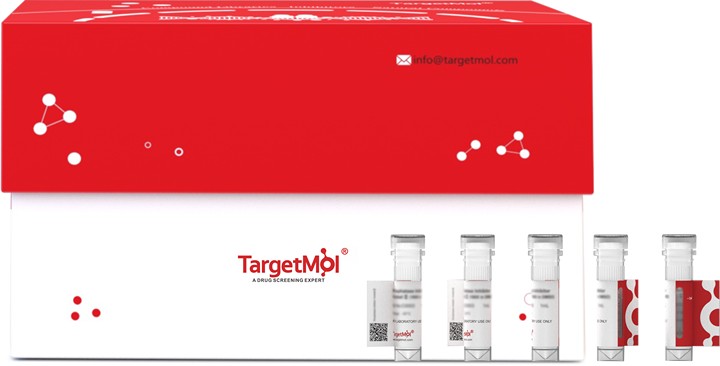 您的购物车当前为空
您的购物车当前为空
MAP1D Protein, Human, Recombinant (His)
一键复制产品信息Methionine aminopeptidase 1D, also known as MAP1D, is a member of the peptidase M24A family. N-terminal methionine removal is an important cellular process required for proper biological activity, subcellular localization, and eventual degradation of many proteins. The enzymes that catalyze this reaction are called Methionine aminopeptidases (MAPs). MAP1D is overexpressed in colon cancer cell lines and colon tumors as compared to normal tissues (at protein level). Downregulation of MAP1D expression by shRNA in HCT-116 colon carcinoma cells reduces anchorage-independent growth in soft agar. MAP1D binds two cobalt ions per subunit. The true nature of the physiological cofactor is under debate. MAP1D is also active with zinc, manganese, or divalent ions. MAP1D removes the amino-terminal methionine from nascent proteins. It may also play an important role in colon tumorigenesis.

MAP1D Protein, Human, Recombinant (His)
一键复制产品信息| 规格 | 价格 | 库存 | 数量 |
|---|---|---|---|
| 5 μg | ¥ 683 | 6-8日内发货 | |
| 10 μg | ¥ 1,130 | 6-8日内发货 | |
| 20 μg | ¥ 1,930 | 5日内发货 | |
| 50 μg | ¥ 4,430 | 5日内发货 |
产品信息
| 生物活性 | Measure by its ability to remove methionine from a fluorogenic peptide substrate H-Met-Gly-Pro-AMC. The resulting GP-AMC is cleaved by human DPPIV/CD26. The specific activity is >30 pmoles/min/μg. |
| 产品描述 | Methionine aminopeptidase 1D, also known as MAP1D, is a member of the peptidase M24A family. N-terminal methionine removal is an important cellular process required for proper biological activity, subcellular localization, and eventual degradation of many proteins. The enzymes that catalyze this reaction are called Methionine aminopeptidases (MAPs). MAP1D is overexpressed in colon cancer cell lines and colon tumors as compared to normal tissues (at protein level). Downregulation of MAP1D expression by shRNA in HCT-116 colon carcinoma cells reduces anchorage-independent growth in soft agar. MAP1D binds two cobalt ions per subunit. The true nature of the physiological cofactor is under debate. MAP1D is also active with zinc, manganese, or divalent ions. MAP1D removes the amino-terminal methionine from nascent proteins. It may also play an important role in colon tumorigenesis. |
| 种属 | Human |
| 表达系统 | Baculovirus Insect Cells |
| 标签 | C-His |
| 蛋白编号 | Q6UB28 |
| 别名 | methionyl aminopeptidase type 1D (mitochondrial),Metap1l,MetAP 1D,MAP1D,MAP 1D |
| 蛋白构建 | A DNA sequence encoding the human MAP1D (NP_954697.1) (Arg 44-Ala 335) was expressed, with an initial Met at the N-terminus and a polyhistidine tag at the C-terminus. Predicted N terminal: Met |
| 蛋白纯度 | > 92 % as determined by SDS-PAGE |
| 分子量 | 33.4 kDa (predicted); 36 kDa (reducing conditions) |
| 内毒素 | < 1.0 EU/μg of the protein as determined by the LAL method. |
| 蛋白性状 | Lyophilized powder |
| 缓冲液 | Lyophilized from a solution filtered through a 0.22 μm filter, containing 50 mM Tris, 100 mM NaCl, pH 8.0.Typically, a mixture containing 5% to 8% trehalose, mannitol, and 0.01% Tween 80 is incorporated as a protective agent before lyophilization. |
| 复溶方法 | A Certificate of Analysis (CoA) containing reconstitution instructions is included with the products. Please refer to the CoA for detailed information. |
| 存储 | It is recommended to store recombinant proteins at -20°C to -80°C for future use. Lyophilized powders can be stably stored for over 12 months, while liquid products can be stored for 6-12 months at -80°C. For reconstituted protein solutions, the solution can be stored at -20°C to -80°C for at least 3 months. Please avoid multiple freeze-thaw cycles and store products in aliquots. |
| 运输方式 | In general, Lyophilized powders are shipping with blue ice. |
| 研究背景 | Methionine aminopeptidase 1D, also known as MAP1D, is a member of the peptidase M24A family. N-terminal methionine removal is an important cellular process required for proper biological activity, subcellular localization, and eventual degradation of many proteins. The enzymes that catalyze this reaction are called Methionine aminopeptidases (MAPs). MAP1D is overexpressed in colon cancer cell lines and colon tumors as compared to normal tissues (at protein level). Downregulation of MAP1D expression by shRNA in HCT-116 colon carcinoma cells reduces anchorage-independent growth in soft agar. MAP1D binds two cobalt ions per subunit. The true nature of the physiological cofactor is under debate. MAP1D is also active with zinc, manganese, or divalent ions. MAP1D removes the amino-terminal methionine from nascent proteins. It may also play an important role in colon tumorigenesis. |





 |
|